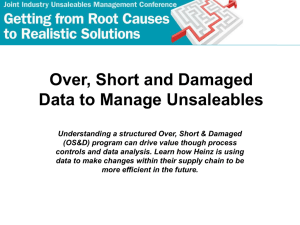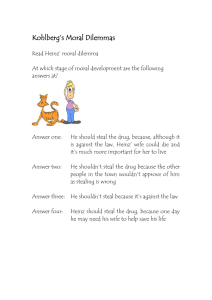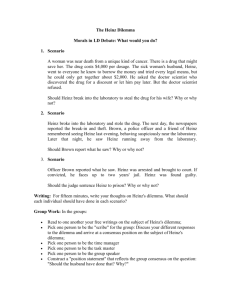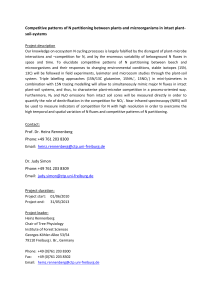Project
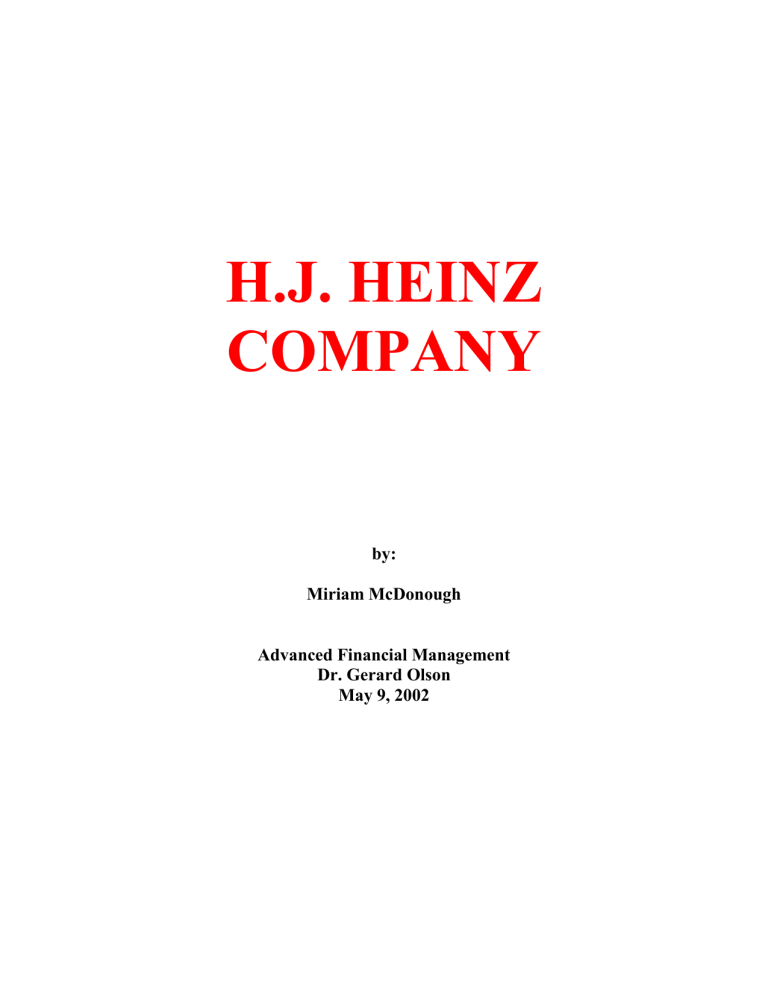
H.J. HEINZ
COMPANY
by:
Miriam McDonough
Advanced Financial Management
Dr. Gerard Olson
May 9, 2002
TABLE OF CONTENTS
Background and Product Lines of Heinz . . . . . . . . . . . . . . . . . . . . . . . . . . . . . . . . . .Page 1
Competition and Position of Heinz in the Industry . . . . . . . . . . . . . . . . . . . . . . . . . . Page 2
Ratio Analysis . . . . . . . . . . . . . . . . . . . . . . . . . . . . . . . . . . . . . . . . . . . . . . . . . . . . .Page 2-4
Beta Analysis . . . . . . . . . . . . . . . . . . . . . . . . . . . . . . . . . . . . . . . . . . . . . . . . . . . . . Page 4-5
Stock Valuation Analysis . . . . . . . . . . . . . . . . . . . . . . . . . . . . . . . . . . . . . . . . . . . . Page 5-6
WACC Analysis . . . . . . . . . . . . . . . . . . . . . . . . . . . . . . . . . . . . . . . . . . . . . . . . . . .Page 6-7
Discussion of Limitations . . . . . . . . . . . . . . . . . . . . . . . . . . . . . . . . . . . . . . . . . . . . . Page 7
Location and Product Lines . . . . . . . . . . . . . . . . . . . . . . . . . . . . . . . . . . . . . . . Appendix A
Comparative Charts . . . . . . . . . . . . . . . . . . . . . . . . . . . . . . . . . . . . . . . . . . . . . Appendix B
Ratio Comparisons . . . . . . . . . . . . . . . . . . . . . . . . . . . . . . . . . . . . . . . . . . . . . . Appendix C
Financial Statements . . . . . . . . . . . . . . . . . . . . . . . . . . . . . . . . . . . . . . . . . . . . .Appendix D
Heinz and S&P 500 Returns . . . . . . . . . . . . . . . . . . . . . . . . . . . . . . . . . . . . . . . Appendix E
Stock Valuation Calculations . . . . . . . . . . . . . . . . . . . . . . . . . . . . . . . . . . . . . . Appendix F
Bond Issues . . . . . . . . . . . . . . . . . . . . . . . . . . . . . . . . . . . . . . . . . . . . . . . . . . . .Appendix G
Determination of WACC Calculations . . . . . . . . . . . . . . . . . . . . . . . . . . . . . . .Appendix H
Value Line . . . . . . . . . . . . . . . . . . . . . . . . . . . . . . . . . . . . . . . . . . . . . . . . . . . . .Appendix I
Bibliography . . . . . . . . . . . . . . . . . . . . . . . . . . . . . . . . . . . . . . . . . . . . . . . . . . . Appendix J
Background and Product Lines
H.J. Heinz Company manufactures and markets a large line of processed food products throughout the world. Established in 1869, Heinz went from selling on the local market, to selling on the national market, to selling on the global market. Heinz is known throughout the world for it’s consistent quality, old-fashioned values and great taste.
When Henry Heinz was only twenty-five years old, he founded H.J. Heinz
Company. Run by family members for decades to follow, Heinz expanded beyond its local start up point and ventured into the global market. Heinz’s first overseas endeavor began in 1905 when it began selling its products in London. From then on, worldwide expansion grew. Heinz acquired companies in various countries such as Italy, Portugal,
Mexico, South Africa, Russia, the Czech Republic, Hungary, South Korea, China, India,
Egypt, Botswana and Zimbabwe, not to mention the companies that it has acquired in the
United States. Heinz in represented in 200 countries across the globe and as fast as their locations have numbered, so have their product lines.
The leading products and major source of cash flow is in the sale of the regular, garden-variety ketchup, condiments, and sauces. Other product lines include convenience meals, frozen foods, pet foods, infant foods, and organic and nutritional foods. Because each country has a different style, culture and taste, the different product lines are sold throughout the world on different levels. (See Appendix A: Locations and
Product Lines)
Today, H.J. Heinz Company stock is traded on the New York Stock Exchange under the ticker symbol HNZ and currently employs 45,800 people. Heinz is in the food processing industry and is a part of the S&P 500.
Competition and Position in the Industry
Heinz’s labels themselves as “one of the world’s greatest food companies” with rivals such as General Mills Inc, Kraft Foods Inc, and Kellogg Co. Looking at a comparative chart, we can see that the S&P 500 returns declined in the middle of this past year, although Heinz’s returns did decrease at various points, they did not decrease by the same severity that the S&P 500 did. The returns on Heinz’s stock, has typically moved with the industry in varying degrees at different points. Over the past five years, the average return of Heinz has been slightly less than the S&P 500. Looking at the calculations and analyses in this project, it can be seen that Heinz has grown and will continue to grow solidly throughout the future. (See Appendix B: Comparative Charts and Appendix E: Heinz and S&P 500 Returns)
Ratio Analysis
Performing a ratio analysis, I am able to look at the value of H.J. Heinz Company and compare it to that of the S&P 500 and the industry. By calculating and analyzing ratios from five different areas such as profitability, liquidity, debt management, market value and efficiency, I am able see how Heinz measures up against it’s peers.
First, I looked at the profitability ratios profit margin, return on assets and return on equity. The profit margin indicates the rate of profit from sales and revenue.
Comparing Heinz’s gross margin to the S&P 500 and the Industry, it is apparent that
Heinz is not as profitable as its competitors are. Although it is more than five points lower than the S&P 500, the profit margin of Heinz shows that its profits are not much lower than the industry’s average profitability. Heinz’s ROA indicates what earnings were generated from invested capital. Again, although there is a significant difference
between Heinz’s ROA and the S&P 500 average, Heinz is right there with the industry.
The Return on Equity demonstrates how profitable a company is in comparison with the industry. The ROE of Heinz is extremely larger than the ROE of both the S&P 500 and the industry. The profitability ratios indicate that although Heinz might not be earning profits high above the average, it is holding its own and gaining enough profit to remain one of the top competitors in the industry.
Analyzing the liquidity ratios, I looked at the current ratio and the quick ratio.
The current ratio measures the ability of Heinz to meet its daily operating expenses and short-term obligations. Heinz’s current ratio shows that it meets its obligation faster and more efficiently that its competitors. The quick ratio measures how fast a company’ assets can be turned into cash. This measurement is also an indication of financial strength. Here, it is seen that although Heinz is more liquid than average in its industry, but is still a bit lower than the S&P 500. These ratios indicate that Heinz able to meet its obligations and is able to liquid it assets in a short amount of time if necessary.
Analyzing debt management ratios, I looked at the debt/equity ratio and the performance of Heinz to the S&P 500 and to the industry. The debt/equity ratio measures a company’s financial leverage, i.e. how much debt and how much equity a company uses to finance its assets. A higher ratio indicates an aggressive investment in assets using debt. Heinz uses an extremely large amount of debt for financing purposes and a significant amount more than the companies making up the S&P 500 and the other companies in its industry. Although, it is less expensive to finance with debt, it might be something that Heinz should look at.
Finally I looked at market value ratios. The P/E ratio for Heinz is between the
S&P 500 and the industry. While the S&P 500’s P/E is 58.7 and the industry’s is 26.1,
Heinz’s P/E is 34.1. This means that although Heinz is not high up on the S&P 500 list, it is above average in its industry. The book value per share ratio also shows that the book value of Heinz’s stock is lower than that of the S&P 500 and the industry.
Currently it is at $4.40, which is more than $2 below the industry and $6 below the S&P
500 average.
Efficiency ratios are used to evaluate the overhead structure of a financial institution. These ratios measure how efficient and therefore how profitable a company is. The total asset turnover of Heinz is above the S&P 500 and exactly equal to the industry’s. This shows that the efficiency and profitability of Heinz is average and right where it is expected to be. While Heinz’s receivables turnover is still higher than the
S&P 500, it is almost one point less than the industry, which indicates a low return of profits for every dollar invested. This is not a cause for major concern, but it does indicate that Heinz’s profits and efficiency are below average and that steps to remedy the situation should be taken.
The Ratio Analysis put Heinz in a comfortable position. Although some indicators imply that Heinz might be in trouble, other indicators imply that Heinz is doing better than others. Taking the good with the bad, Heinz is seemingly average. (See
Appendix C: Ratio Comparisons and Appendix D: Financial Statements)
Beta Analysis
Using the stock prices from each month over the past five years for Heinz and for the S&P 500, I calculated both of their average monthly returns. From the average
monthly returns I ran a regression and found a beta of .3357 for Heinz. Some of the published betas for Heinz include .32 from Yahoo, .33 from MSN Money, and .55 from
Value Line. Each of the betas, including the one that I found, show that Heinz has a below average market risk. (See Appendix E: Heinz and S&P 500 Returns)
Stock Valuation Analysis
In order to find the value of the stock for the year ending April 30, 2002, I first found the expected return using CAPM and the Gordon Constant Model and the average dividend growth rate for Heinz. I found the expected return (K) by finding the next expected dividend. I found the next expected dividend by finding the average rate of dividend growth over the past five year to be 8%. Using the Capital Asset Pricing Model,
I found the expected return to be 6%. Further, I found another expected return using the
Gordon Constant Growth to be 11.894%. I then determined the dividend for the year
2002 to be $1.674. Using the dividend of $1.674, the stock price of 42.82, and the average growth rate of 8.00%, I found the expected stock price at the end of the fiscal year for Heinz (April 30, 2002) to be $42.99. I then took the dividends from the past five years, the expected dividend for 2002 and the expected stock price for 2002 and found the respective cash flows for the years 1997 through 2002 using both of the expected returns that I found.
By summing all the cash flows and expected cash flows I found the value of
Heinz’s stock to be $37.10 using the expected return from CAPM and the value of
Heinz’s stock to be $27.53 using the expected return from the Gordon Constant Growth
Model. Heinz’s current stock price is $42.82; therefore I found that Heinz’s stock is overvalued. With the CAPM expected return, the stock is overvalued by $5.72 and with
the Gordon Constant Growth Rate Model expected return, the stock is overvalued by
$15.29. (See Appendix F: Stock Valuation Calculations)
WACC Analysis
Finding the WACC, I am able to see a weighted average of each of Heinz’s component costs. In order to find the WACC, I first had to find the cost of common stock, the cost of long-term debt, and the cost of preferred stock. I also found the weights of common stock, long-term debt, and preferred stock.
When I found the cost of common stock, I used two different methods: the
Gordon Constant Growth Model and the Capital Asset Pricing Model. In using the
Gordon Constant Growth Model, I used the stock price as of April 23, 2002 of $42.82. I used the average dividend growth rate of 8% and the next expected dividend of $1.674.
This found the cost of common stock to be 11.894%. Using the CAPM approach, I used the U.S. Treasury Bill Rate of 3.55% as the risk-free rate, a market rate of return of 8%, and a published beta of .55. Using these three numbers, I found the cost of common stock to be 6%.
I found the cost of long-term debt from a bond issue that will mature on March
15, 2032. It’s yield to maturity and cost is 6.927%. (See Appendix G: Bond Issues) I found the cost of preferred stock by using the dividend paid per share of $1.70 and the par value of Heinz’s preferred stock of $10.00. Using these two numbers I found the cost of preferred stock to be 17%.
Then using the book values of common stock, long-tem debt, and preferred stock,
I found the following weights: 15.20%, 84.80%, and 0% respectively. Using the effective tax rate of 35% and the costs and weights of common stock, long-term debt and
preferred stock, I then computed the WACC in two ways. First I calculated the WACC to be 5.626% using the Gordon Constant Growth Model. Then I calculated the WACC to be 4.730% using the Capital Asset Pricing Model. Both of these numbers seem low, but that is a result of a highly weighted long-term debt and the nonexistent weight of preferred stock. (See Appendix H: Determination of WACC)
Discussion of Limitations
When calculating the ratios, the beta, the value of the stock and the weighted average cost of capital for Heinz Company, there is a chance for error because of all the variables to be observed. Because there are many steps in calculating each of these, there are many possible areas for error. The main issue is the data collection. There are various sources that provide different data that is often similar, but usually never the same. Therefore, I used reliable sources, and most often the same source in the calculations involved in my project in an attempt to eliminate the possible error. I also performed the calculations for valuing the stock and determining the WACC in two different ways in an attempt to further reduce the possibility of error.
BondPage. www.bondpage.com
BIBLIOGRAPHY
Compustat Database. www.compustat.com
H.J. Heinz Company Website. www.heinz.com
MSN Money. www.moneycentral.com
Multex Investor. www.multexinvestor.com
Securities and Commission Exchange. www.sec.gov
Yahoo Finance. www.finance.yahoo.com
